Abstract
Stress corrosion cracking (SCC) is an important destruction form of materials such as stainless steel, nickel-based alloy and their welded components in nuclear reactor pressure vessels and pipes. The existing popular quantitative prediction models of SCC crack growth rate are mainly influenced by fracture toughness values KJc or Jc. In particular, the composite constraint, containing the in-plane constraints and out-of-plane constraints around the crack front, has a significant influence on the fracture toughness of structures in nuclear power plants. Since the plastic strain gradient is a characterization parameter of the quantitative prediction model for crack growth rate, it may be a characterization parameter of composite constraint. On the basis of the experimental data at a low temperature of alloy steel 22NiMoCr3-7 used in nuclear pressure vessels, the gradient of equivalent plastic strain DPEEQ around the crack fronts at different constraint levels was calculated using the finite element method, which introduces a new non-dimensional constraint parameter Dp, to uniformly characterize the in-plane and out-of-plane constraint effects. Compared with constraint parameters APEEQ or Ap, the process of obtaining parameters DPEEQ or Dp is much simpler and easier. In a wide range, a single correlation curve was drawn between parameter Dp and normalized fracture toughness values KJc/Kref or Jc/Jref of specimens at a low or high constraint level. Therefore, regardless of whether the constraint levels of the structures or standard specimens are low or high, constraint parameter Dp can be used to measure their fracture toughness. To build an evaluation method that has structural integrity and safety while containing the composite constraint effects, in addition to accurate theoretical interpretation, further verification experiments, numerical simulations and detailed discussions are still needed.
1. Introduction
Stress corrosion cracking (SCC), which often occurs in nuclear powers‘ structural materials in high-temperature and high-pressure water environments, is a failure mode caused by a variety of factors, including tensile stress, susceptible materials and environmental parameters [1,2]. From the microscopic point of view, there are transgranular cracks and intergranular cracks in the SCC region, mainly composed of corrosion defects, such as point corrosion, intergranular corrosion, crevice corrosion, and overall corrosion. As an important form of deterioration of many welded components made of stainless steel and nickel-based alloy, SCC has received increasing attention [3,4]. The existing, popular quantitative prediction model of SCC crack growth rate is mainly influenced by fracture toughness values KJc or Jc. A large number of experiments and theoretical analyses show that constraining factors regarding the crack tip have significant effects on the fracture toughness of structures.
Due to the ability to resist plastic deformation around the crack front, the composite constraint, which can be divided into in-plane constraints and out-of-plane constraints, has been widely known to be considerably related to the study of material fracture behavior. For example, the measured fracture toughness KJc is greatly influenced by crack-tip constraint effects [5,6]. The in-plane constraint is mainly related to the specimen or structure size in the direction of crack propagation, such as the uncracked ligament length. Additionally, the out-of-plane constraint is significantly related to the specimen or structure size in the direction parallel to the crack front, for example, the specimen thickness. To improve the accuracy of structural integrity assessment, researchers have proposed many cracking characteristic parameters to determine the driving forces of the cracking behavior in recent decades. The parameters T, A2, Q, and h are only considered to describe the in-plane constraint effect, and they have no ability to uniformly characterize the composite constraint effect. Therefore, these parameters can be only quantified as one single parameter, respectively. For two-parameter concepts such as K-T [2], J-Tstress [7,8,9], J-A2 [10], J-Q [11], and J-h [12], with an examination of experimental data, it is found that these investigated concepts differ significantly, and they are not suitable parameters to determine both in-plane and out-of-plane constraints [13]. Constraint parameter Ap [14,15] is put forward based on the areas that are surrounded by the equivalent plastic strain isolines ahead of crack tips. Additionally, this parameter is able to characterize both of the two types of constraints properly. Meanwhile, the correlation lines of normalized fracture toughness values KJc/Kref and Jc/Jref with APEEQ, Ap [16] are also obtained. However, the precise calculations of parameters APEEQ and Ap in the specific areas are very complex and inconvenient, and calculation results are likely affected by grid partition.
To identify a type of composite constraint parameter that can be simply calculated, the constraint parameter should be sensitive to both in-plane and out-of-plane constraints. The slip/dissolution–oxidation model has been considered a reasonable model for the description of SCC behavior in an oxygenated aqueous system in recent decades [17,18,19,20]. The SCC behavior can induce intergranular and transgranular cracks, which will modify the crystal structure of the specimen locally. It should be considered that the grain boundary structure also has a significant effect on the SCC behavior. Based on the strain gradient theory, the strain redistribution and strain rate at the crack tip can be easily obtained at the crack tip [19]. Additionally, the strain rate at the crack tip can lead to interfacial film degradation. According to the elastic–plastic finite element method (FEM), the gradient of the equivalent plastic strain can be calculated [21]. For the conventional electrochemical environment, the crack growth rate is essentially consistent with the plastic strain gradient at the crack tip. Experiments suggest that fracture toughness KJc is relatively related to the crack growth rate [21] under the composite constraint effect. Since the plastic strain gradient is a characterization parameter of the crack growth rate prediction model, it may be a characterization parameter of composite constraint. This also suggests that the equivalent plastic strain gradient (DPEEQ) in the fracture plastic zone may be sensitive to composite constraints. Compared with the parameter APEEQ of Yang [14,15], the achievement of parameter DPEEQ is much simpler and easier. The calculation process of DPEEQ is also very convenient. By means of the reference average gradient of equivalent plastic strain (Dref) along the crack front of a three-dimensional tensile specimen, the dimensionless constraint parameter Dp (Dp = DPEEQ/Dref) is supposedly an effective parameter to measure both in-plane and out-of-plane constraint effects.
In this paper, based on the experimental data of fracture toughness KJc at a low temperature [13], the distributions of equivalent plastic strain at the crack fronts of the experimental samples were obtained. The new characterization parameters DPEEQ and Dp were obtained by a three-dimensional FEM, and the results show that plastic strain gradient is a combination of composite constraints in a wide range. Whether parameters DPEEQ and Dp can effectively describe and evaluate the composite constraint effect was also investigated. It is helpful to build an evaluation method that has structural integrity and safety while containing the composite constraint effect.
2. Theory and Methods
The film slip/dissolution–oxidation often occurs in nuclear-grade steels in high-temperature and oxygen-containing environments. The Ford model [22] is widely accepted to estimate the SCC crack growth rate of nuclear-grade steels structures, in which the crack growth rate da/dt can be obtained by
where is the strain rate at a specific position ahead of the crack tip, which is represented by da/dt. m is the exponent of the measured current decay curve. represents the oxidation rate constant, which is related to the material properties and electrochemical environment at the crack tip, and it is shown as
where the molecular weight of the metal is represented by Mmol; ρ represents its density; F represents the Faraday constant; zc represents variation in charge because of the oxidation process; represents the time before current decay; represents the oxidation current density; the degradation strain of oxide film is represented by .
Considering the difficulty to obtain the accurate strain rate at the crack tip, the equivalent plastic strain εp at a characteristic distance r0 is put forward to substitute εct in Equation (1), which is
In Equation (4), the strain rate at r0 is represented by dεp/da. Therefore, the SCC growth rate can be written as
The strain gradient can be written in Equation (6) as follows:
Without regard to the first term of Equation (6), dεp/da can be expressed as
Finally, the SCC growth rate can be written as
Equation (8) can be used to calculate the SCC propagation at the defects of actual light water reactor components [21]. The equivalent plastic strain gradient (dεp/dr) at r0, which is the only mechanical factor affecting the stress corrosion cracking behavior, can be easily calculated. According to the basic estimating formula, the equivalent plastic strain gradient (dεp/dr) is considered as the main crack driving force in the stress corrosion cracking propagation process at defects of actual LWR components [23,24,25].
A new characterization parameter DPEEQ at r0 was defined as follows:
where DPEEQ is the average gradient of equivalent plastic strain, and r0 is a characteristic distance along the crack tip. Additionally, DPEEQ can also be written as the average rate of equivalent plastic strain. The characteristic distance r0 is determined by the contour rσ0/Jref = 2 at the midpoint of the crack front. Here, Jref refers to the average value of calculated J-integrals for a reference standard specimen. Along the crack front of the evaluated specimen, DPEEQ can be defined as dεp/dr. In the finite element calculation, at each node in the thickness direction, the corresponding values of DPEEQ at r0 can be calculated by the derivation method and averaging method based on the values of equivalent plastic strain εp.
Furthermore, along the crack front of the reference standard specimen at a high restraint level, by means of the equivalent plastic strain gradient (DPEEQ) and the reference average gradient of equivalent plastic strain (Dref), a new normalized characterization parameter Dp was defined as
where Dref is the average gradient of equivalent plastic strain for a reference standard specimen when the calculated J = Jref.
3. The Finite Element Model
3.1. Geometry Model
According to ASTM Standard E1921-02(2002), the compact tension (C(T)) specimens and three-point bending (SE(B)) specimens are rested at a low temperature of Tt = −60 °C to represent low and high constraint situations [13]. The geometry and dimension configuration of C(T) and deep notched SE(B)d specimens are shown in Table 1 and Figure 1. The out-of-plane constraint must be considered, which varies with the specimen thickness B, while the in-plane constraint changes with variations in the specimen width W, the ratio of crack length a to W, and the specimen type.

Table 1.
Specimen sizes [13].
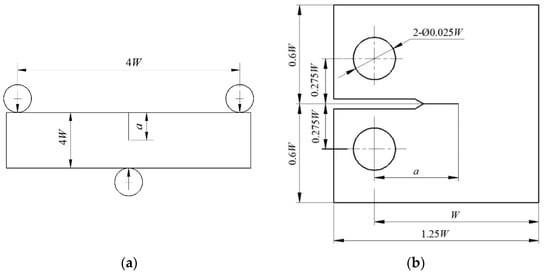
Figure 1.
Geometry sizes: (a) SE(B); (b) C(T) specimens.
3.2. Material Properties
The steel 22NiMoCr3-7, which is widely used in the pressure vessel of nuclear power plants, was investigated. The relationship between stress and strain can be written according to [26,27] as follows:
where ε is the total of elastic strain and plastic strain; σ is the total stress; ε0 and σ0 are the material yield strain and yield stress, respectively; n represents the material strain hardening exponent; the offset coefficient is represented by α. The FEM analysis was carried out by using the mechanical property data of steel 22NiMoCr3-7 at Tt = −60 °C [13], and the constitutive parameters are given in Table 2.

Table 2.
Constitutive parameters of 22NiMoCr3-7 steel at −60 °C [13].
3.3. The Finite Element Model
Three different finite element models were established according to Table 1 in the commercial finite element program ABAQUS. There are two types of C(T) specimens— C(T)25 when the ratio a/W = 0.5162 and C(T)50 when the ratio a/W = 0.5104, respectively. Additionally, there is one type of SE(B)10 × 10d specimen with the ratio a/W = 0.5245. All models used eight-node isoperimetric elements (C3D8R). In order to reduce the calculation time, only 1/4 of the C(T) specimen and 1/2 of the SE(B) specimen were simulated. Additionally, unruptured ligaments were used in symmetrical boundary conditions. The typical meshes (containing 45 280 elements in C(T)50 specimen and 44 047 elements in SE(B)10 × 10d specimen) and refined meshes at crack fronts of these specimens are shown in Figure 2.
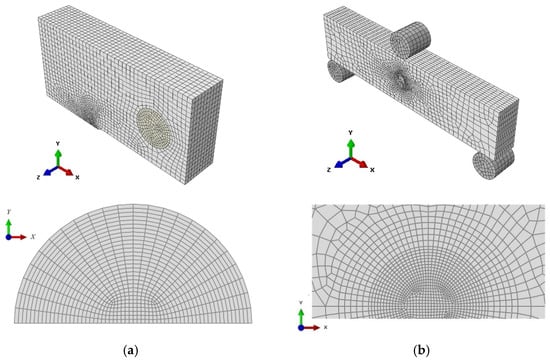
Figure 2.
Mesh of global model and mesh around crack front: (a) C(T)50 specimen and (b) SE(B)10 × 10d specimen.
4. Results
The fracture toughness tests were based on ASTM Standard E1921-02 (2002) at a typical test temperature Tt = −60 °C. The measured fracture toughness KJc under a small area yield conditions at the crack fronts was obtained. According to Young’s modulus E and Poison’s ratio ν in Table 2, the fracture toughness Jc can be obtained by
To build the relationship between fracture toughness values KJc and Jc, and parameters DPEEQ and Dp in the simulated experiments, loads were applied to keep the J integral at the midpoint of crack front equal to the fracture toughness Jc listed in Table 3. Then, the stress–strain field around crack fronts was calculated using the commercial finite element code in ABAQUS.

Table 3.
Experimental data of fracture toughness [13] and plastic strain gradient calculated by FEM.
Experimental data of fracture toughness at Tt = −60 °C and plastic strain gradient calculated by FEM for constraint analysis are both listed in Table 3.
4.1. Equivalent Plastic Strain and its Gradient
The distribution of equivalent plastic strain around crack fronts in a SE(B)10 × 10d specimen (W = 10 mm, B = 10 mm and a/W = 0.5245, load Jc = 84.147 kJ/m2) was simulated at Tt = −60 °C. To acquire a more accurate stress–strain field, a fine mesh was used at the vicinity of the crack front. The specimen thickness was divided into five equal parts. Figure 3 illustrates the strain distribution in six cross-sections along the direction of the specimen thickness. The equivalent plastic strains around the crack fronts of a SE(B)10 × 10d specimen with varying loads Jc (Jc = 29.65, 47.46, 61.35, 75.43, and 84.14 kJ/m2) are shown in Figure 4. The radius of the study area is 0.5 mm. As the load increases, the equivalent plastic strain around the crack front becomes increasingly higher, and it could be found that a much higher strain area is located on the free surface of the specimen, which implies that the equivalent plastic strain may be a uniform measurement of composite constraint.
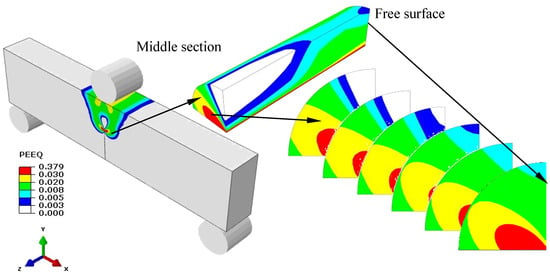
Figure 3.
Equivalent plastic strain around crack fronts in sections.


Figure 4.
Equivalent plastic strain around crack fronts: (a) Jc = 29.65 kJ/m2, (b) Jc = 47.46 kJ/m2, (c) Jc = 61.35 kJ/m2, (d) Jc = 75.43 kJ/m2, and (e) Jc = 84.14 kJ/m2.
Figure 5 depicts the curves of calculated J integrals around crack fronts in a SE(B)10 × 10d specimen (W = 10 mm, B = 10 mm and a/W = 0.5245). The Jc curves were plotted at Tt = −60℃ against the ratio of z/B, where z/B = 0 represents the middle section and z/B = 0.5 represents the free surface of the specimen. It can be concluded that the central area (z/B = 0) has a higher J integral, while the surface area (z/B = 0.5) has a lower J integral. Figure 5 also implies that the J integral undergoes a prominent change from the free surface to the middle section of the specimen, indicating that Jc is not sensitive to the out-of-plane constraint, as it can not effectively characterize the out-of-plane constraint.
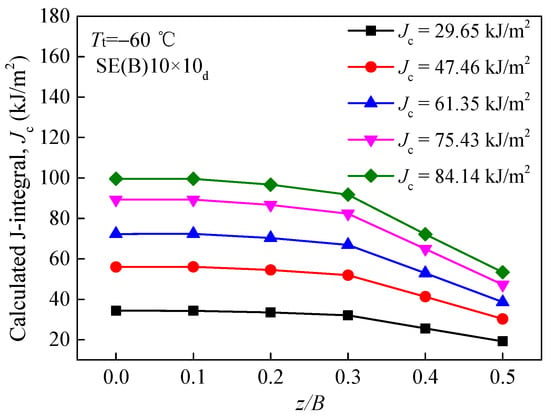
Figure 5.
Calculated J integrals around crack fronts.
Based on the normalized specimen thickness z/B at Tt = −60 °C, the curves of equivalent plastic strain gradient DPEEQ around the crack front in the SE(B)10 × 10d specimen with the increasing Jc are shown in Figure 6. It is apparent that a lower DPEEQ appears in the central area, with z/B = 0, and a higher DPEEQ appears in the surface area, with z/B = 0.5. This indicates that parameter DPEEQ is associated with the specimen thickness B, which indicates that DPEEQ is sensitive to the out-of-plane constraint. Therefore, DPEEQ may be able to characterize it.
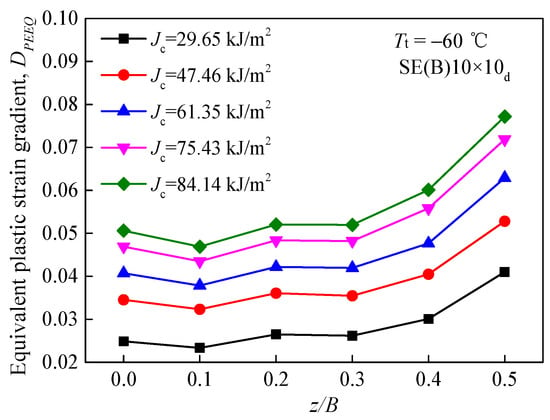
Figure 6.
Equivalent plastic strain gradients around crack fronts.
4.2. Characterization of Composite Constraint
The characteristic distance r0 is determined by the contour rσ0/Jref = 2 at the midpoint of the crack front. Here, Jref refers to the average value of calculated J integrals for a reference standard specimen. Subsequently, when the J integral at the midpoint of crack front equals the value of fracture toughness Jc in Table 3, based on the stress–strain field around crack fronts, the values of the constraint parameter DPEEQ in three different specimens, whose in-plane and out-of-plane constraints are totally different, can be calculated. To examine whether the parameter DPEEQ can measure the composite constraint, the average values of DPEEQ at r0 through the direction of specimen thickness along the crack front of all specimens were calculated and are also listed in Table 3. Additionally, most particularly, the achievement of DPEEQ is much simpler and easier than that of APEEQ. Afterward, the fracture toughness values KJcc and Jc determined by experiments were drawn as functions of DPEEQ. In a wide range, the relationships between KJc, Jc, and DPEEQ are depicted in Figure 7 and Figure 8. It is obvious that the data are not diffused. The composite constraint parameter DPEEQ was found to have a good linear relationship with fracture toughness values KJc and Jc in a wide range. The values of KJc or Jc increase with the higher DPEEQ. DPEEQ is apparently sensitive to the normalized fracture toughness values KJc and Jc. The parameter DPEEQ is sensitive to both in-plane and out-of-plane constraints.
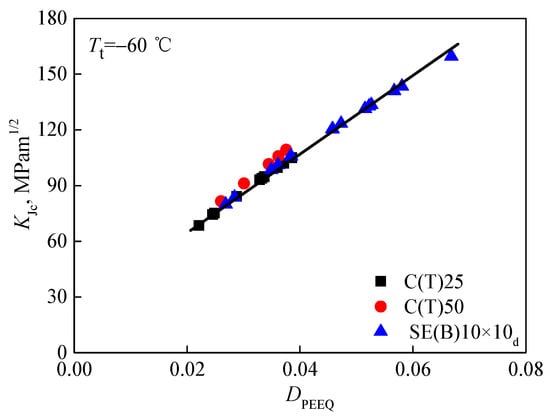
Figure 7.
Relation between fracture toughness KJc and constraint parameter DPEEQ.
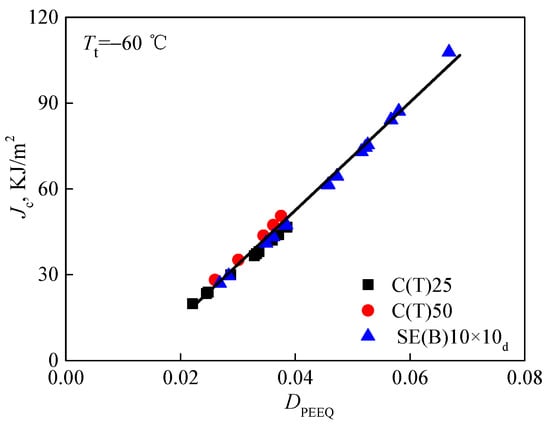
Figure 8.
Relation between fracture toughness Jc and constraint parameter DPEEQ.
4.3. Correlation of Dp between Composite Constraint
The highly constrained C(T)25 specimen was selected as the standard specimen. The average values of KJc and Jc of 10 C(T)25 standard specimens were defined as the reference fracture toughness values of Kref and Jref. Along the direction of the specimen thickness, Dref was defined as the reference gradient of equivalent plastic strain; it can be obtained from the stress–strain field around the crack front when the J integral at the midpoint of crack front equals Jref. Therefore, the non-dimensional parameter Dp (Dp = DPEEQ/Dref) could be calculated. The calculated Dp values are also listed in Table 3.
In Figure 9 and Figure 10, based on the reference fracture toughness values Kref and Jref, and the reference equivalent plastic strain gradient Dref, the non-dimensional fracture toughness values KJc/Kref and Jc/Jref in a wide range were obtained, and they were used as two functions of the non-dimensional constraint parameter Dp for all specimens with different composite constraints at the crack fronts. The parameter Dp (Dp= DPEEQ/Dref) also has a uniform relationship with KJc/Kref and Jc/Jref of specimens at low and high constraint levels. Therefore, Dp can characterize the in-plane constrain, as well as the out-of-plane constrain. The non-dimensional constraint parameter Dp is able to measure the fracture toughness of different standard specimens or structures at a low or high constraint level.
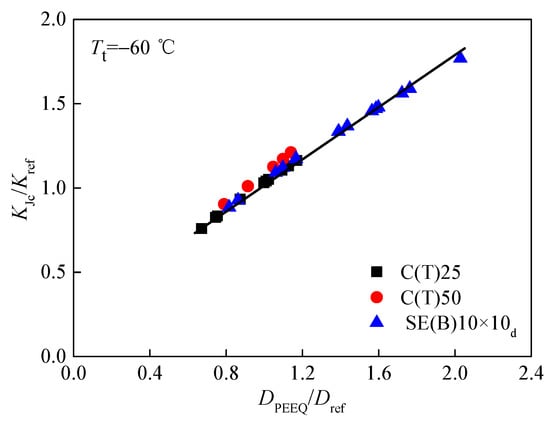
Figure 9.
Relation between non-dimensional fracture toughness KJc/Kref and constraint parameter Dp.
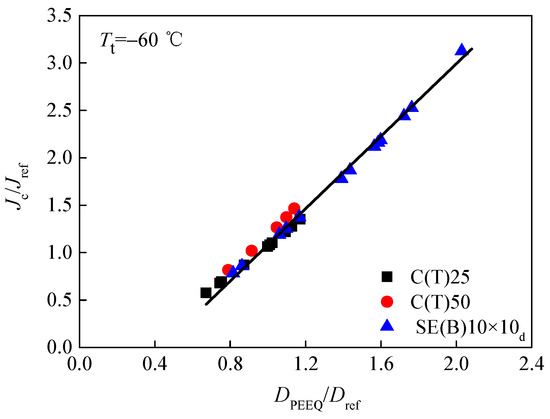
Figure 10.
Relation between non-dimensional fracture toughness Jc/Jref and constraint parameter Dp.
5. Conclusions
Based on the equivalent plastic strain gradient at a characteristic distance r0 ahead of crack fronts in three types of specimens, constraint parameter DPEEQ and non-dimensional constraint parameter Dp were calculated and analyzed. Different from parameter APEEQ, Ap obtained by Yang [14,15], obtaining parameters DPEEQ and Dp is much simpler and easier. DPEEQ and Dp both have the capability to characterize the composite constraint effect, which was examined in this study. For various specimens at a low or high constraint level, the concept derived from DPEEQ and Dp has a good linear relationship with normalized fracture toughness values KJc/Kref and Jc/Jref in a wide range, and it can be selected as a uniform parameter to measure the composite constraint effect. The correlation between Dp and KJc/Kref or Jc/Jref can be used to measure the fracture toughness in a wide range. Therefore, regardless of whether the structures or standard specimens have low or high constraint levels, constraint parameter Dp can be used to measure their fracture toughness. Studies also have shown that the composite constraint at the crack tip has some relationship with the test temperature Tt [5] and that the correlation curves need to be established between them. To build an evaluation method that has structural integrity and safety while containing the composite constraint effect, in addition to accurate theoretical interpretation, further verification experiments, numerical simulations and detailed discussions are still needed.
Author Contributions
Conceptualization, L.Z.; data curation, Z.S.; methodology, L.Z. and Z.W.; software, Z.S.; validation, Z.S.; visualization, L.Z.; writing—original draft preparation, L.Z.; writing—review and editing, Z.W. and F.Y.; formal analysis, Z.S.; investigation, F.Y. All authors have read and agreed to the published version of the manuscript.
Funding
This research was funded by the Natural Science Foundation of Shaanxi Province (Grant Number 2020JM-523). This research was also funded by the National Natural Science Foundation of China (Grant Numbers 11502195 and 52175145).
Institutional Review Board Statement
Not applicable.
Informed Consent Statement
Not applicable.
Data Availability Statement
The data presented in this study are available on request from the corresponding author.
Conflicts of Interest
The authors declare no conflict of interest.
Nomenclature
| a | Crack length |
| APEEQ | Area surrounded by the equivalent plastic strain isoline |
| Ap | A new constraint parameter |
| A2 | A constraint parameter |
| B | Specimen thickness |
| DP | Normalized parameter of the equivalent plastic strain gradient |
| DPEEQ | Equivalent plastic strain gradient |
| Dref | Average gradient of equivalent plastic strain at r0 of a reference standard specimen |
| E | Young’s modulus |
| F | Faraday’s constant |
| h | Stress triaxiality |
| J | J integral |
| Jc | Average of calculated J integrals |
| Jref | Average of calculated J integrals for a reference standard specimen |
| KJc | Measured fracture toughness |
| Kref | Fracture toughness of a reference standard specimen |
| Mmol | Molecular weight of the metal atomic |
| m | Oxidation current decay curve |
| N | Hardening exponent in the Ramberg–Osgood equation |
| Q | A constraint parameter |
| r | Distance along the crack front |
| r0 | Characteristic distance |
| Tt | Test temperature |
| Tstress | Intensity of the crack tip’s stress field |
| Time before the current decay onset | |
| W | Specimen width |
| z | Thickness coordinate at the crack front |
| zc | Charge change caused by oxidation process |
| α | Offset coefficient of the material |
| σ0 | Yield stress |
| dεp/dr | Equivalent plastic strain gradient at a fixed distance ahead of the crack tip |
| ε0 | Yield strain |
| εf | Oxide film’s degradation strain |
| Strain rate at a fixed distance ahead of the crack tip | |
| εp | Equivalent plastic strain |
| Constant of oxidation rate | |
| ρ | Density of the metal |
| ν | Poisson’s ratio |
References
- Meng, F.M.; Wang, J.Q.; Han, E.H.; Shoji, T.; Ke, W. Microstructure near scratch on alloy 690tt and stress corrosion induced by scratching. Acta Metall. Sin. 2011, 47, 839–846. [Google Scholar]
- Xue, H.; Ogawa, K.; Shoji, T. Effect of welded mechanical heterogeneity on local stress and strain ahead of stationary and growing crack tips. Nucl. Eng. Des. 2009, 239, 628–640. [Google Scholar] [CrossRef]
- Zhao, L.Y.; Cui, Y.H.; Yang, F.Q.; Xue, H. Analysis on crack driving force at stress corrosion cracking tip induced by scratch in Nickel-based alloy. Rare Met. Mater. Eng. 2018, 47, 1399–1406. [Google Scholar] [CrossRef]
- Horn, R.M.; Gordon, G.M.; Ford, F.P.; Cowan, R.L. Experience and assessment of stress corrosion cracking in L-grade stainless steel BWR internals. Nucl. Eng. Des. 1997, 174, 313–325. [Google Scholar] [CrossRef]
- Hohe, J.; Hebel, J.; Friedmann, V.; Siegele, D. Probabilistic failure assessment of ferritic steels using the master curve approach including constraint effects. Eng. Fract. Mech. 2007, 74, 1274–1292. [Google Scholar] [CrossRef]
- Neimitz, A. Fracture toughness of structural elements: The influence of the in-and out-of-plane constraints on fracture toughness. Mater. Sci. 2006, 42, 61–77. [Google Scholar] [CrossRef]
- Guo, W. Elastoplastic three dimensional crack border field—II. Asymptotic solution for the field. Eng. Fract. Mech. 1993, 46, 105–113. [Google Scholar] [CrossRef]
- Guo, W. Elasto-plastic three-dimensional crack border field-III. Fracture parameters. Eng. Fract. Mech. 1995, 51, 51–71. [Google Scholar] [CrossRef] [Green Version]
- She, C.; Guo, W. The out-of-plane constraint of mixed-mode cracks in thin elastic plates. Int. J. Solids Struct. 2007, 44, 3021–3034. [Google Scholar] [CrossRef] [Green Version]
- Chao, Y.J.; Yang, S.; Sutton, M.A. On the fracture of solids characterized by one or two parameters: Theory and practice. J. Mech. Phys. Solids 1994, 42, 629–647. [Google Scholar] [CrossRef]
- O’Dowd, N.; Shih, C. Family of crack-tip fields characterized by a triaxiality parameter—I. Structure of fields. J. Mech. Phys. Solids 1991, 39, 989–1015. [Google Scholar] [CrossRef]
- Clausmeyer, H.; Kussmaul, K.; Roos, E. Influence of stress state on the failure behavior of cracked components made of steel. Appl. Mech. Rev. 1991, 44, 77–92. [Google Scholar] [CrossRef]
- Hebel, J.; Hohe, J.; Friedmann, V.; Siegele, D. Experimental and numerical analysis of in-plane and out-of-plane crack tip constraint characterization by secondary fracture parameters. Int. J. Fract. 2007, 146, 173–188. [Google Scholar] [CrossRef]
- Yang, J.; Wang, G.Z.; Xuan, F.Z.; Yu, S.D. Unified characterisation of in-plane and out-of-plane constraint based on crack-tip equivalent plastic strain. Fatigue Fract. Eng. Mater. Struct. 2013, 36, 504–514. [Google Scholar] [CrossRef]
- Yang, J.; Wang, G.Z.; Xuan, F.Z.; Tu, S.T. Unified correlation of in-plane and out-of-plane constraint with fracture resistance of a dissimilar metal welded joint. Eng. Fract. Mech. 2014, 115, 296–307. [Google Scholar] [CrossRef]
- Mu, M.Y.; Wang, G.Z.; Xuan, F.Z.; Tu, S.T. Unified parameter of in-plane and out-of-plane constraint effects and its correlation with brittle fracture toughness of steel. Int. J. Fract. 2014, 190, 87–98. [Google Scholar] [CrossRef]
- Andresen, P.L.; Ford, F. Fundamental modeling of environmental cracking for improved design and lifetime evaluation in BWRs. Int. J. Press. Vessel. Pip. 1994, 59, 61–70. [Google Scholar] [CrossRef]
- Shoji, T.; Lu, Z.; Murakami, H. Formulating stress corrosion cracking growth rates by combination of crack tip mechanics and crack tip oxidation kinetics. Corros. Sci. 2010, 52, 769–779. [Google Scholar] [CrossRef]
- Yang, F.Q.; Xue, H.; Zhao, L.Y.; Fang, X.R. A quantitative prediction model of SCC rate for nuclear structure materials in high temperature water based on crack tip creep strain rate. Nucl. Eng. Des. 2014, 278, 686–692. [Google Scholar] [CrossRef]
- Zaferani, S.H.; Miresmaeili, R.; Pourcharmi, M.K. Mechanistic models for environmentally-assisted cracking in sour service. Eng. Fail. Anal. 2017, 79, 672–703. [Google Scholar] [CrossRef]
- Xue, H.; Shoji, T. Quantitative prediction of EAC crack growth rate of sensitized type 304 stainless steel in boiling water reactor environments based on EPFEM. J. Press. Vessel. Technol. 2006, 129, 460–467. [Google Scholar] [CrossRef]
- Ford, F.P. Quantitative prediction of environmentally assisted cracking. Corrosion. 1996, 52, 375–395. [Google Scholar] [CrossRef] [Green Version]
- Lu, Z.; Shoji, T.; Meng, F.; Xue, H.; Qiu, Y.; Takeda, Y.; Negishi, K. Characterization of microstructure and local deformation in 316NG weld heat-affected zone and stress corrosion cracking in high temperature water. Corros. Sci. 2011, 53, 1916–1932. [Google Scholar] [CrossRef]
- Peng, Q.; Kwon, J.; Shoji, T. Development of a fundamental crack tip strain rate equation and its application to quantitative prediction of stress corrosion cracking of stainless steels in high temperature oxygenated water. J. Nucl. Mater. 2004, 324, 52–61. [Google Scholar] [CrossRef]
- Koshiishi, M.; Hashimoto, T.; Obata, R. Application of the FRI crack growth model for neutron-irradiated stainless steels in high-temperature water of a boiling water reactor environment. Corros. Sci. 2017, 123, 278–288. [Google Scholar] [CrossRef]
- Panter, J.; Viguier, B.; Cloué, J.-M.; Foucault, M.; Combrade, P.; Andrieu, E. Influence of oxide films on primary water stress corrosion cracking initiation of alloy 600. J. Nucl. Mater. 2006, 348, 213–221. [Google Scholar] [CrossRef] [Green Version]
- Xue, H.; Wang, Z.; Wang, S.; He, J.; Yang, H. Characterization of mechanical heterogeneity in dissimilar metal welded joints. Mater. 2021, 14, 4145. [Google Scholar] [CrossRef]
Publisher’s Note: MDPI stays neutral with regard to jurisdictional claims in published maps and institutional affiliations. |
© 2022 by the authors. Licensee MDPI, Basel, Switzerland. This article is an open access article distributed under the terms and conditions of the Creative Commons Attribution (CC BY) license (https://creativecommons.org/licenses/by/4.0/).